Topic Modeling
The topic labels on Atlas Data Maps describe the themes that points have in common across different regions of your data. These labels are generated when you upload data with topic modeling enabled (which is enabled by default).
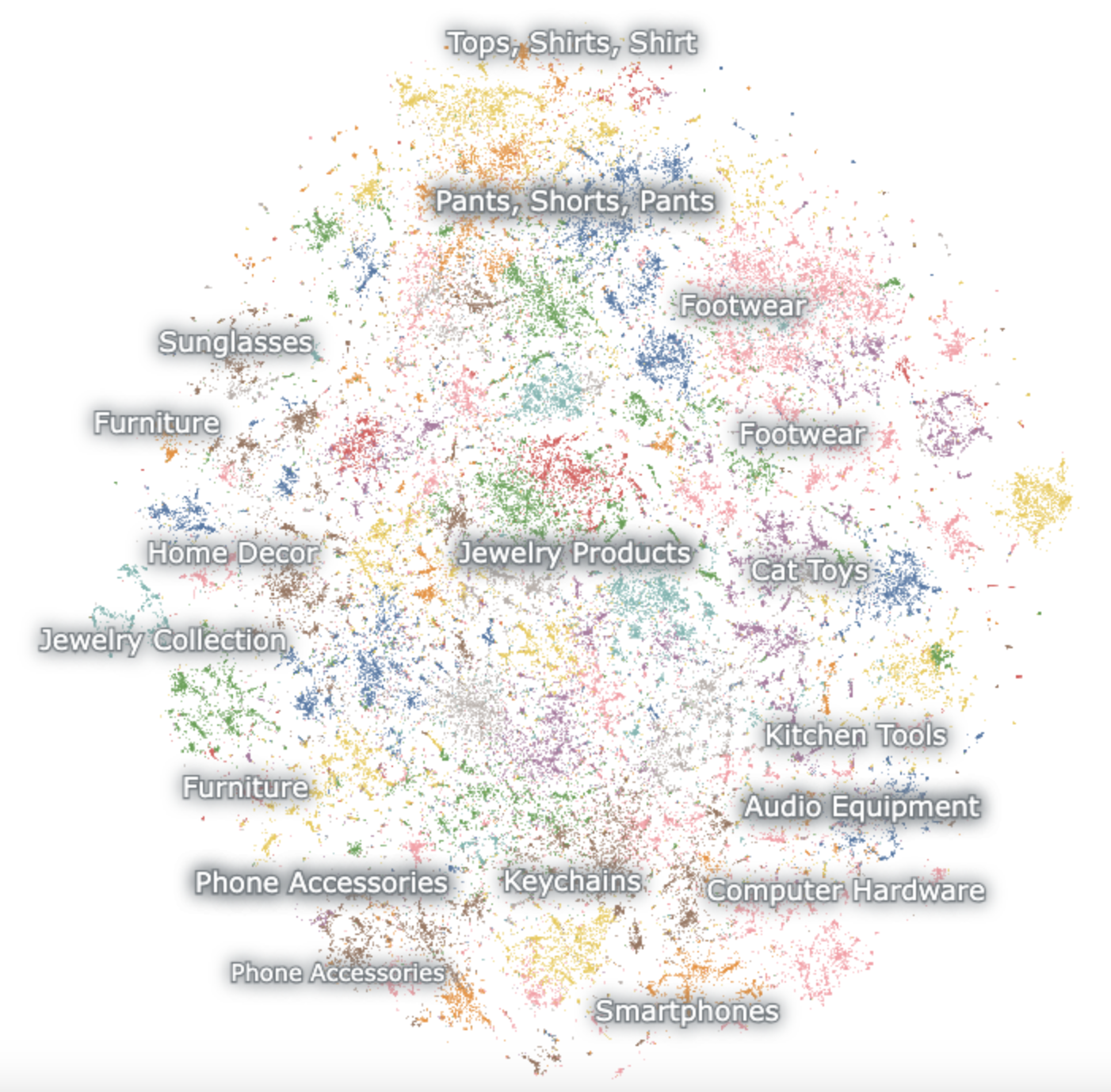
Show Topic Labels
To show topics on your Atlas map, check the "Show Nomic Topic labels" switch in View Settings:

Reading Topics Like a Geographic Map
Like a map in a phone app or a classic tri-fold tucked in your glove compartment, Atlas serves as a guide through a landscape - with your data instead of geography.
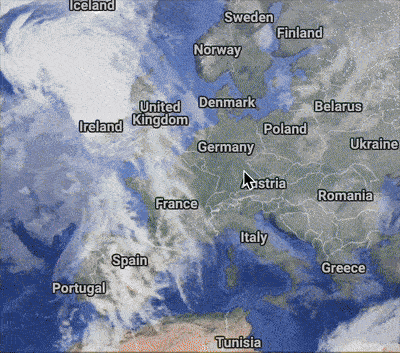
Zooming in through many levels of geographic detail
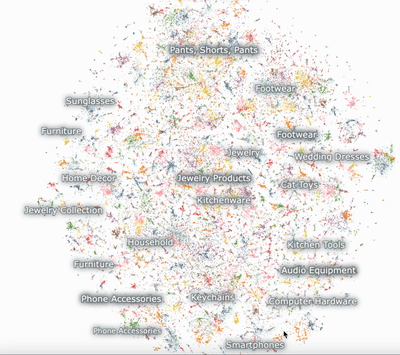
Zooming in through 3 levels of topic model granularity in an Atlas Data Map
Consider a digital map of Earth.
- When we see the whole world on our screen at once, we can see labels of continents, countries, ocean names and mountain ranges.
- Zooming in brings more granularity, like states and provinces, rivers, and lakes.
- Zooming in further, names of cities, towns and villages come into view.
- Zooming in even further, we may see labeled buildings, roads, paths, bridges, or monuments.
In Atlas, topics reveal themselves in a similar way as you zoom in on the map.
Topic Level Hierarchy
The topic model organizes your data into a hierachy allowing you to explore clusters in your data at different levels of resolution.
There are either 2 or 3 levels in a topic hierarchy, depending on the size of your dataset.
When you examine an individual data point in Atlas, its topics at each level of the hierarchy are visible in the left toolbar, ordered from most broad down to most specific.
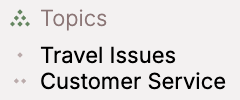
Example 2-level topics (broad and medium) for a point from a smaller dataset
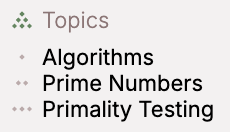
Example 3-level topics (broad, medium, and specific) for a point from a larger dataset
Color by Topic
The topic model can be used to recolor your data map at different levels of the topic model.
To change your map color to reflect the topic model, adjust the Color field in the View Settings to Nomic Topic: broad, medium, or specific.
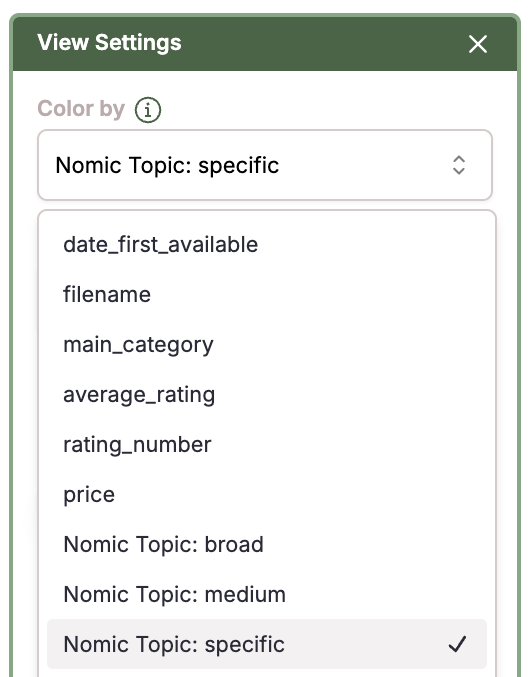
This will color each point according to its topic at the level you've specified.
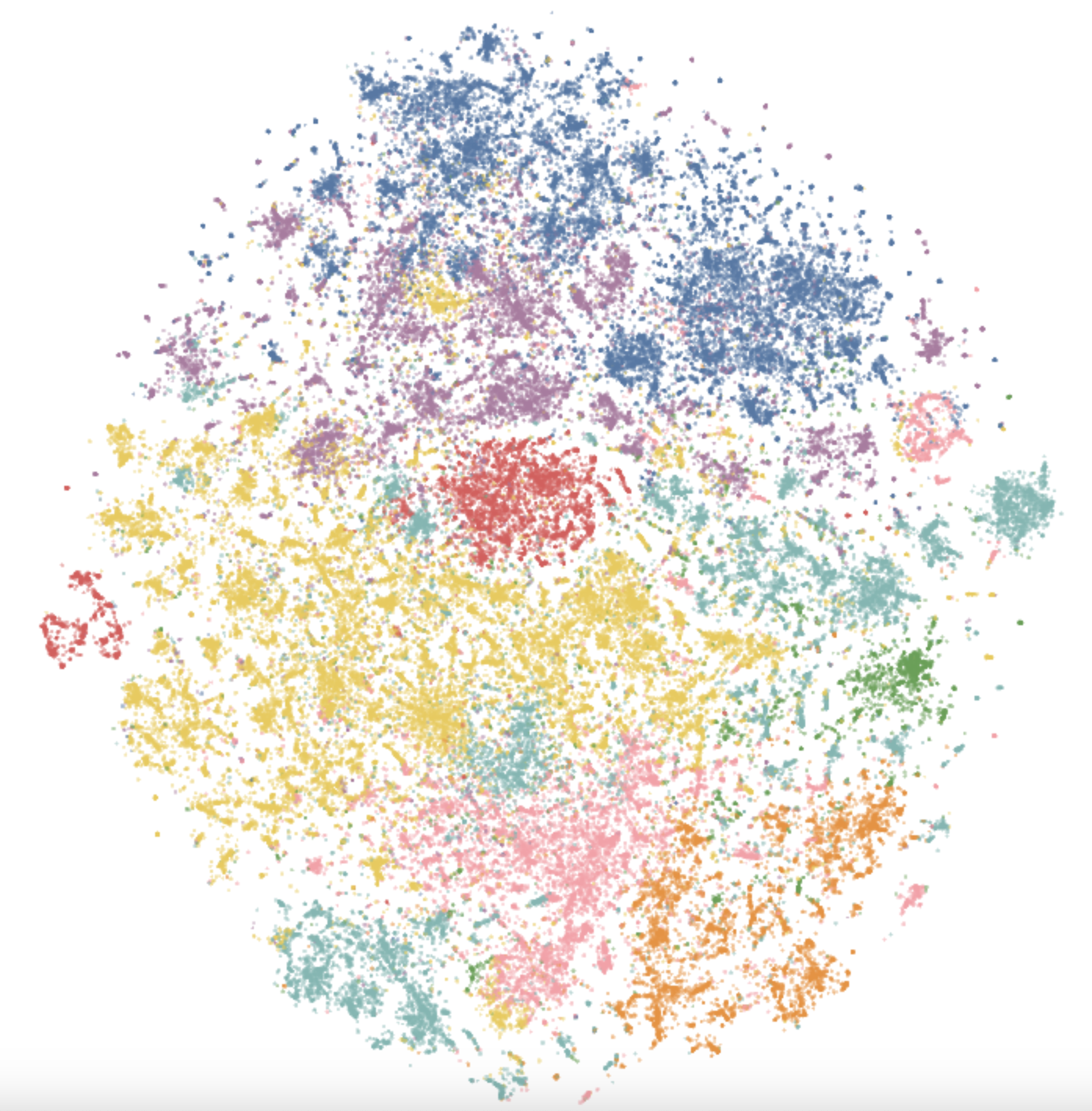
Broad topics
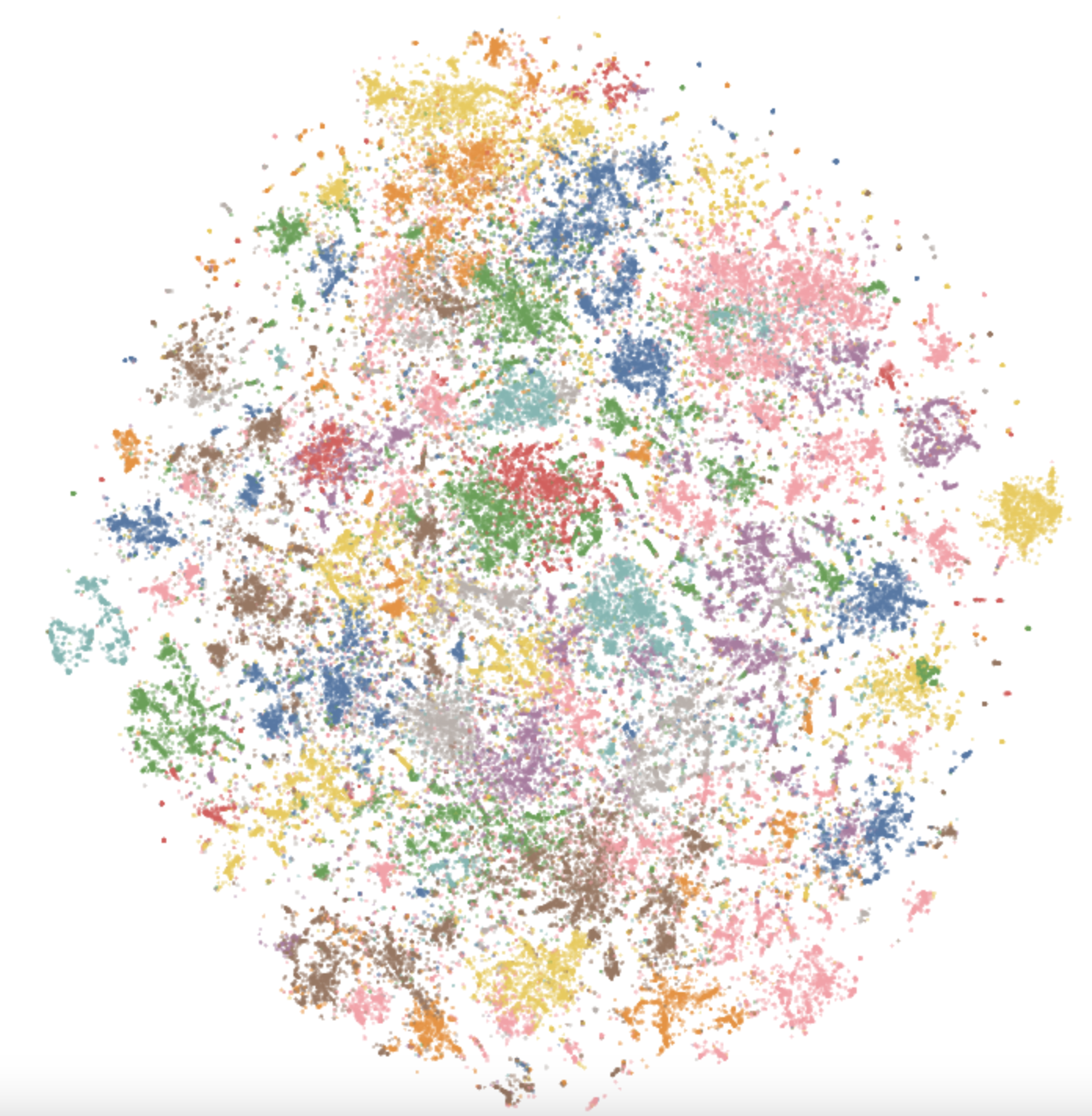
Medium topics
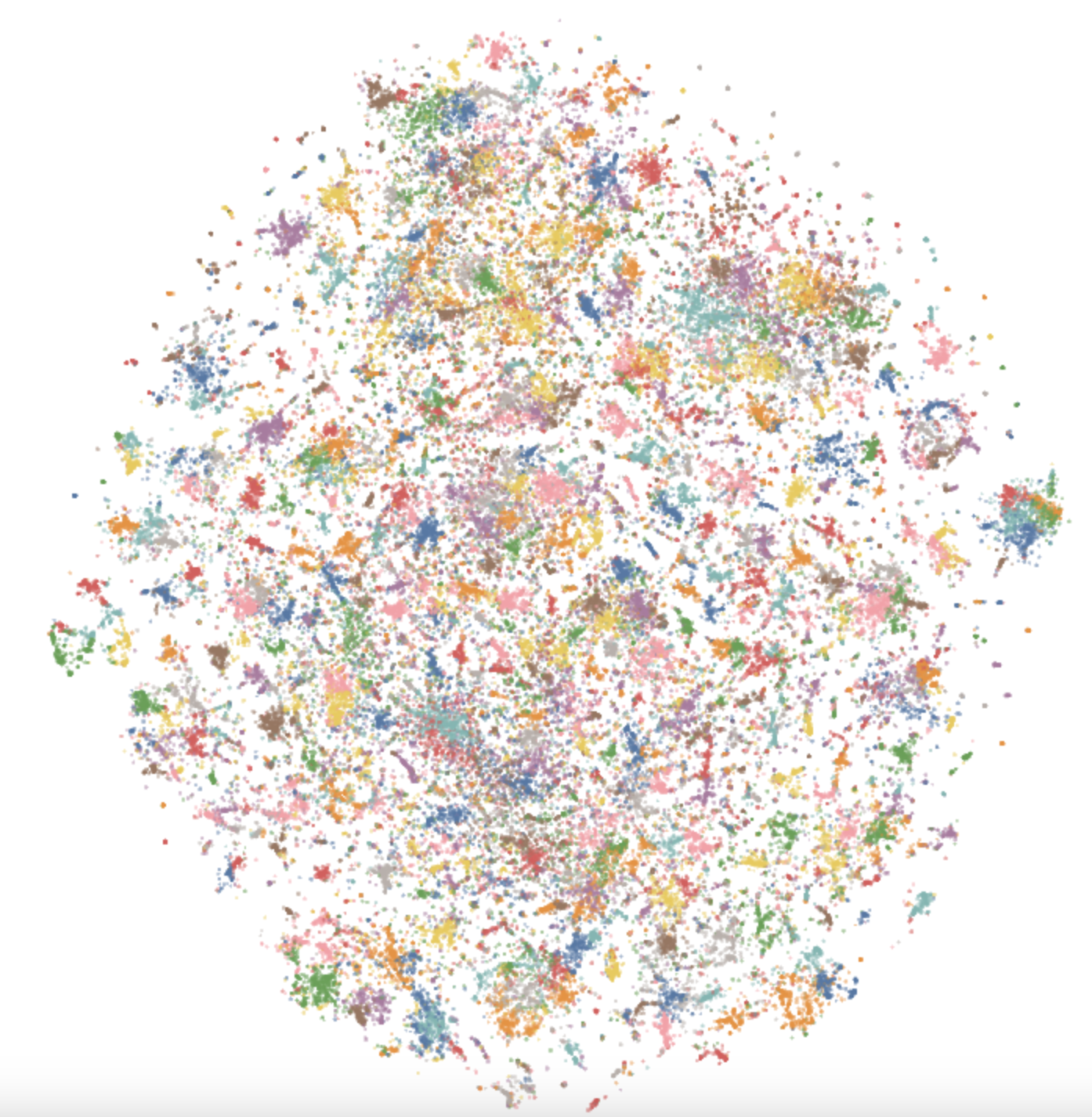
Specific topics
Filter by Topic
You can create a selection that filters for a particular topic three different ways:
Click Topic Label Directly
Click the topic label directly to activate or deactive a filter for that topic.
Click Topic in Legend
Click the topic name in the legend in View Settings to activate or deactive a filter for that topic.
Create Filter Selection for Topic
In the left toolbar, create a Filter selection, choose Nomic Topic: broad, medium, or specific, and then search for the topic you want to filter for.
Edit Topic Labels
An editor of a dataset can update topic labels from within the Atlas Map. This is useful if you want to customize your topic labels for presentation purposes or rename the topic labels to suit your specific data.
In the View Settings panel, click the "Edit Topics" toggle to enter edit mode. In edit mode, click on a topic label to open a modal where the topic label can be altered. Within that modal the most prominent keywords related to that topic can also be viewed.
Once an edited topic label is saved, it is immediately reflected in the map, and propagated to the server. Other users of the map will see the updated topic upon refreshing the map.
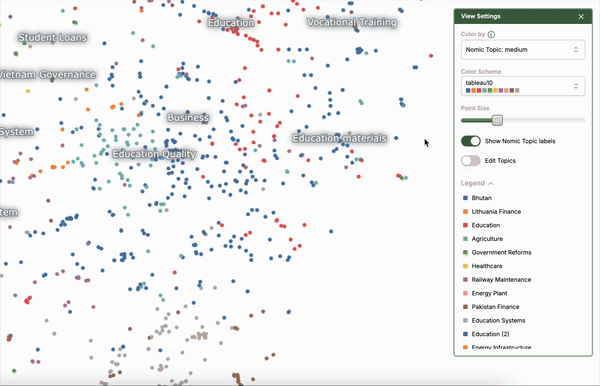
Configure Topic Model
When creating your Atlas Dataset, you can configure whether to build a topic model, and which field from your data to use for generating topic labels. See our API Reference for more detail.
Access Topics Using the Python SDK
The topics which the Atlas system generates behind the scenes is directly accessible via Python. Information is available about topic hierarchy and topic density. Topic information can be used for downstream pipelines like visualization, analyses, and predictions.
Your embedding information can be accessed in the map.topics attribute of the AtlasDataset:
from nomic import AtlasDataset
map = AtlasDataset('my-dataset').maps[0]
# Pandas df of your data with columns ID, topic_depth_n, topic_depth_n+1, etc.
print(map.topics.df)
id_ topic_depth_1 topic_depth_2 topic_depth_3
0 +Bw Baby, Ray, Sunglasses Apparel T-Shirts (2)
1 fHM Phone Protector Music Genre Blues Music
2 9Ts Lighting Replacement Years Hyundai Engines
3 6mU Women's Fashion (3) Footwear (14) Women's Sandals
4 8j8 Women's Fashion (3) Tops, Shirts, Shirt Women's Tops (2)
... ... ... ... ...
117238 GRs Electronics (5) Smartphones (3) Computer Peripherals
117239 AULT Electronics (5) Computer Hardware (2) Computer Upgrades
117240 P0U Electronics (5) Computer Hardware (2) Computer Hardware
117241 AWnV Electronics (5) Computer Hardware (2) Computer Hardware
117242 5Vg Electronics (5) Computer Hardware (2) Computer Hardware
[117243 rows × 4 columns]
Topic Metadata
Pandas dataframe where each row corresponds to a unique topic. Metadata associated with each topic includes:
- topic depth
- a human-readable topic description (topic label)
- identifying keywords that differentiate the topic from other topics
# Returns a Pandas df
print(map.topics.metadata)
depth topic_id topic_depth_1 topic_description topic_short_description topic_depth_2 topic_depth_3
0 1 0 Women's Fashion (3) women/tops/dress/sandals/womens/casual/shoes/p... Women's Fashion (3) NaN NaN
1 1 1 Electronics (5) USB/Bluetooth/iPhone/charging/Intel/cable/HDMI... Electronics (5) NaN NaN
2 1 2 Jewelry Collection (2) jewelry/IceCarats/Jewelry/Type/ICECARATS/Sterl... Jewelry Collection (2) NaN NaN
3 1 3 Phone Protector phone/Galaxy/Samsung/dogs/Watch/protector/scre... Phone Protector NaN NaN
4 1 4 Pool Supplies Pool/pool/Floats/chair/Brand/Amazon/Lathe/floa... Pool Supplies NaN NaN
... ... ... ... ... ... ... ...
605 3 507 Lighting Replacement hose/garden/Garden/watering/Hose/ft/plants/Jet... Garden Hose Plumbing S... Garden Hose
606 3 508 Lighting Replacement Rate/9930/gallons/207/months/38℃/125PSI/GPM/34... Water Pump Plumbing S... Water Pump
607 3 509 Lighting Replacement NPT/¼/½/PSI/Pump/Straight/tire/pump/12V/Connec... Tire Pump Plumbing S... Tire Pump
608 3 510 Lighting Replacement drain/Drain/sink/pipe/Sink/stopper/steel/toile... Plumbing Fixtures Plumbing S... Plumbing Fixtures
609 3 511 Lighting Replacement shower/water/Shower/filter/solar/fountain/head... Bathroom Essentials Plumbing S... Bathroom Essentials
610 rows × 7 columns
Topic Hierarchy��
Learn more about your topic breakdown as a Python dictionary. What are the most general topics, and which sub-topics do they contain?
# map.topics.hierarchy is a dict
hierarchy = map.topics.hierarchy
print(f'Your depth 1 (most general) topics are: {hierarchy.keys()}')
Your depth 1 (most general) topics are: dict_keys([
("Women's Fashion (3)", 1),
('Electronics (5)', 1),
('Jewelry Collection (2)', 1),
...
])
You can use higher-level topic keys to access lower-level topics in your hierarchy.
import random
# List the subtopics in a random top-level topic
random_topic_1 = random.choice(list(hierarchy.keys()))
print(f'The general topic {random_topic_1} contains subtopics {hierarchy[random_topic_1]}')
The general topic ('Footwear (14)', 2) contains subtopics [
'Shoes (3)', 'Sandal', 'Sneaker Culture', ..., "Women's Sandals"
]
Topic Groups
By providing a level of hierarchy, get a list of dictionaries where each item is a distinct topic at that level.
Keys for that topic include subtopics, subtopic_ids, topic_id, topic_short_description, topic_long_description, and datum_ids.
your_depth_level = 2
print(map.topics.group_by_topic(your_depth_level)[0])
{
'subtopics': ['Miscellaneous (3)'],
'subtopic_ids': [87],
'topic_id': 16,
'topic_short_description': 'Audio Equipment (3)',
'topic_long_description': 'Bluetooth/speaker/Speaker/music/CarPlay/MP3/prevention/bluetooth/stereo/sound/karaoke/Loss/Radio/⭐/radio',
'datum_ids': {'61c', '/WM', 'Rsw', 'q6I', ..., 'AVjU'}
}